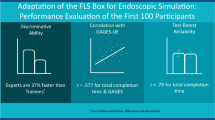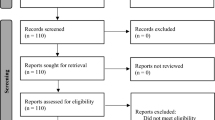Abstract
While laparoscopic simulation-based training is a well-established component of general surgery training, no such requirement or standardized curriculum exists for robotic surgery. Furthermore, there is a lack of high-fidelity electrocautery simulation training exercises in the literature. Using Messick’s validity framework, we sought to determine the content, response process, internal content and construct validity of a novel inanimate tissue model that utilizes electrocautery for potential incorporation in such curricula. A multi-institutional, prospective study involving medical students (MS) and general surgery residents (PGY1-3) was conducted. Participants performed an exercise using a biotissue bowel model on the da Vinci Xi robotic console during which they created an enterotomy using electrocautery, followed by approximation with interrupted sutures. Participant performance was recorded and then scored by crowd-sourced assessors of technical skill, along with three of the authors. Construct validity was determined via difference in Global Evaluative Assessment of Robotic Skills (GEARS) score, time to completion, and total number of errors between the two cohorts. Upon completion of the exercise, participants were surveyed on their perception of the exercise and its impact on their robotic training to determine content validity. 31 participants were enrolled and separated into two cohorts: MS + PGY1 vs. PGY2-3. Time spent on the robotic trainer (0.8 vs. 8.13 h, p = 0.002), number of bedside robotic assists (5.7 vs. 14.8, p < 0.001), and number of robotic cases as primary surgeon (0.3 vs. 13.1, p < 0.001) were statistically significant between the two groups. Differences in GEARS scores (18.5 vs. 19.9, p = 0.001), time to completion (26.1 vs. 14.4 min, p < 0.001), and total errors (21.5 vs. 11.9, p = 0.018) between the groups were statistically significant as well. Of the 23 participants that completed the post-exercise survey, 87% and 91.3% reported improvement in robotic surgical ability and confidence, respectively. On a 10-point Likert scale, respondents rated the realism of the exercise 7.5, educational benefit 9.1, and effectiveness in teaching robotic skills 8.7. Controlling for the upfront investment of certain training materials, each exercise iteration cost ~ $30. This study confirmed the content, response process, internal structure and construct validity of a novel, high-fidelity and cost-effective inanimate tissue exercise which successfully incorporates electrocautery. Consideration should be given to its addition to robotic surgery training programs.



Similar content being viewed by others
Data availability
Data available on request from the authors.
References
ScienceDaily (2000) FDA approves New Robotic Surgery Device. ScienceDaily. https://www.sciencedaily.com/releases/2000/07/000717072719.htm
Annualreports.com. Intuitive Annual Report 2018. (n.d.). https://www.annualreports.com/HostedData/AnnualReportArchive/i/NASDAQ_ISRG_2018.pdf
Intuitive | ISRG for investors. Intuitive Annual Report 2019. (n.d.). https://isrg.gcs-web.com/static-files/31b5c428-1d95-4c01-9c85-a7293bac5e05
Perez RE, Schwaitzberg S (2019) Robotic surgery: finding value in 2019 and beyond. Ann Laparosc Endosc Surg 4:51. https://doi.org/10.21037/ales.2019.05.02
Pradarelli JC, Thornton JP, Dimick JB (2017) Who is responsible for the safe introduction of new surgical technology?: An important legal precedent from the Da Vinci surgical system trials. JAMA Surg 152(8):717–718. https://doi.org/10.1001/jamasurg.2017.0841
Cooper MA, Ibrahim A, Lyu H, Makary MA (2015) Underreporting of robotic surgery complications. J Healthc Qual 37(2):133–138. https://doi.org/10.1111/jhq.12036
Foell K, Finelli A, Yasufuku K, Bernardini MQ, Waddell TK, Pace KT et al (2013) Robotic surgery basic skills training: evaluation of a pilot multidisciplinary simulation-based curriculum. Can Urol Assoc J 7(11–12):430–434. https://doi.org/10.5489/cuaj.222
Connolly M, Seligman J, Kastenmeier A, Goldblatt M, Gould JC (2014) Validation of a virtual reality-based robotic surgical skills curriculum. Surg Endosc 28(5):1691–1694. https://doi.org/10.1007/s00464-013-3373-x
Green CA, Chern H, O’Sullivan PS (2018) Current robotic curricula for surgery residents: a need for additional cognitive and psychomotor focus. Am J Surg 215(2):277–281. https://doi.org/10.1016/j.amjsurg.2017.09.040
Dulan G, Rege RV, Hogg DC, Gilberg-Fisher KM, Arain NA, Tesfay ST et al (2012) Developing a comprehensive, proficiency-based training program for robotic surgery. Surgery 152(3):477–488. https://doi.org/10.1016/j.surg.2012.07.028
Winder JS, Juza RM, Sasaki J, Rogers AM, Pauli EM, Haluck RS et al (2016) Implementing a robotics curriculum at an academic general surgery training program: our initial experience. J Robot Surg 10(3):209–213. https://doi.org/10.1007/s11701-016-0569-9
Moit H, Dwyer A, De Sutter M, Heinzel S, Crawford D (2019) A standardized robotic training curriculum in a general surgery program. JSLS. https://doi.org/10.4293/JSLS.2019.00045
Chen R, Rodrigues Armijo P, Krause C, Siu KC, Oleynikov D, Force SRT (2020) A comprehensive review of robotic surgery curriculum and training for residents, fellows, and postgraduate surgical education. Surg Endosc 34(1):361–367. https://doi.org/10.1007/s00464-019-06775-1
Satava RM, Stefanidis D, Levy JS, Smith R, Martin JR, Monfared S et al (2020) Proving the effectiveness of the fundamentals of robotic surgery (FRS) skills curriculum: a single-blinded, multispecialty multi-institutional randomized control trial. Ann Surg 272(2):384–392. https://doi.org/10.1097/SLA.0000000000003220
Stegemann AP, Ahmed K, Syed JR, Rehman S, Ghani K, Autorino R et al (2013) Fundamental skills of robotic surgery: a multi-institutional randomized controlled trial for validation of a simulation-based curriculum. Urology 81(4):767–774. https://doi.org/10.1016/j.urology.2012.12.033
Khan MTA, Patnaik R, Lee CS, Willson CM, Demario VK, Krell RW et al (2022) Systematic review of academic robotic surgery curricula. J Robot Surg. https://doi.org/10.1007/s11701-022-01500-y
Hung AJ, Zehnder P, Patil MB, Cai J, Ng CK, Aron M et al (2011) Face, content and construct validity of a novel robotic surgery simulator. J Urol 186(3):1019–1024. https://doi.org/10.1016/j.juro.2011.04.064
Kelly DC, Margules AC, Kundavaram CR, Narins H, Gomella LG, Trabulsi EJ et al (2012) Face, content, and construct validation of the da Vinci Skills Simulator. Urology 79(5):1068–1072. https://doi.org/10.1016/j.urology.2012.01.028
Moglia A, Ferrari V, Morelli L, Ferrari M, Mosca F, Cuschieri A (2016) A systematic review of virtual reality simulators for robot-assisted surgery. Eur Urol 69(6):1065–1080. https://doi.org/10.1016/j.eururo.2015.09.021
Messick S (1998) Test validity: a matter of consequence. Soc Indic Res 45(1):35–44. https://doi.org/10.1023/A:1006964925094
Lee CS, Khan MT, Patnaik R, Stull MC, Krell RW, Laverty RB (2022) Model development of a novel robotic surgery training exercise with electrocautery. Cureus 14(4):e24531. https://doi.org/10.7759/cureus.24531
Aghazadeh MA, Jayaratna IS, Hung AJ, Pan MM, Desai MM, Gill IS et al (2015) External validation of global evaluative assessment of robotic skills (GEARS). Surg Endosc 29(11):3261–3266. https://doi.org/10.1007/s00464-015-4070-8
Kiely DJ, Gotlieb WH, Lau S, Zeng X, Samouelian V, Ramanakumar AV et al (2015) Virtual reality robotic surgery simulation curriculum to teach robotic suturing: a randomized controlled trial. J Robot Surg 9(3):179–186. https://doi.org/10.1007/s11701-015-0513-4
Holst D, Kowalewski TM, White LW, Brand TC, Harper JD, Sorensen MD et al (2015) Crowd-sourced assessment of technical skills: differentiating animate surgical skill through the wisdom of crowds. J Endourol 29(10):1183–1188. https://doi.org/10.1089/end.2015.0104
Chen C, White L, Kowalewski T, Aggarwal R, Lintott C, Comstock B et al (2014) Crowd-sourced assessment of technical skills: a novel method to evaluate surgical performance. J Surg Res 187(1):65–71. https://doi.org/10.1016/j.jss.2013.09.024
Lendvay TS, White L, Kowalewski T (2015) Crowdsourcing to assess surgical skill. JAMA Surg 150(11):1086–1087. https://doi.org/10.1001/jamasurg.2015.2405
Kowalewski TM, Comstock B, Sweet R, Schaffhausen C, Menhadji A, Averch T et al (2016) Crowd-sourced assessment of technical skills for validation of basic laparoscopic urologic skills tasks. J Urol 195(6):1859–1865. https://doi.org/10.1016/j.juro.2016.01.005
Goldenberg M, Lee JY (2018) Surgical education, simulation, and simulators—updating the concept of validity. Curr Urol Rep 19(7):1–5. https://doi.org/10.1007/s11934-018-0799-7
Carmines EG, Zeller RA (1979) Reliability and validity assessment. SAGE Publications, Thousand Oaks
Cook DA, Beckman TJ (2006) Current concepts in validity and reliability for psychometric instruments: theory and application. Am J Med 119(2):166.e7–16. https://doi.org/10.1016/j.amjmed.2005.10.036
Cronbach LJ, Meehl PE (1955) Construct validity in psychological tests. Psychol Bull 52(4):281–302. https://doi.org/10.1037/h0040957
White LW, Kowalewski TM, Dockter RL, Comstock B, Hannaford B, Lendvay TS (2015) Crowd-sourced assessment of technical skill: a valid method for discriminating basic robotic surgery skills. J Endourol 29(11):1295–1301. https://doi.org/10.1089/end.2015.0191
Awan M, Zagales I, McKenney M, Kinslow K, Elkbuli AACGME (2011) Duty hours restrictions and their effects on surgical residency training and patients outcomes: a systematic review. J Surg Educ. https://doi.org/10.1016/j.jsurg.2021.06.001
Schlottmann F, Herbella FAM, Patti MG (2021) Simulation for foregut and bariatric surgery: current status and future directions. J Laparoendosc Adv Surg Tech A 31(5):546–550. https://doi.org/10.1089/lap.2021.0080
Patnaik R, Khan MT, Yamaguchi S, Fritze DM (2022) building a low-cost and low-fidelity kidney transplant model: a technical report on the San Antonio kidney transplant model. Cureus 14(4):e23883. https://doi.org/10.7759/cureus.23883
Patnaik R, Khan MTA, Willis RE, Yamaguchi S, Scott DJ, Oh T et al (2022) The San Antonio kidney transplant model: validity evidence and proficiency benchmarks. Global Surg Educ-J Assoc Surg Educ 1(1):39
Tam V, Zenati M, Novak S, Chen Y, Zureikat AH, Zeh HJ et al (2017) Robotic pancreatoduodenectomy biotissue curriculum has validity and improves technical performance for surgical oncology fellows. J Surg Educ 74(6):1057–1065. https://doi.org/10.1016/j.jsurg.2017.05.016
Marecik SJ, Prasad LM, Park JJ, Jan A, Chaudhry V (2008) Evaluation of midlevel and upper-level residents performing their first robotic-sutured intestinal anastomosis. Am J Surg 195(3):333–337. https://doi.org/10.1016/j.amjsurg.2007.12.013
Hung AJ, Jayaratna IS, Teruya K, Desai MM, Gill IS, Goh AC (2013) Comparative assessment of three standardized robotic surgery training methods. BJU Int 112(6):864–871. https://doi.org/10.1111/bju.12045
Lee C, Khan M, Patnaik R, Krell R, Stull M, Laverty R (2022) Model development of a novel robotic surgery training exercise with electrocautery. Cureus 14(4):e24531. https://doi.org/10.7759/cureus.24531
Patnaik R, Stefanidis D (2019) Outcome-based training and the role of simulation. comprehensive healthcare simulation: surgery and surgical subspecialties. Springer, pp 69–78
Willis RE, Richa J, Oppeltz R, Nguyen P, Wagner K, Van Sickle KR et al (2012) Comparing three pedagogical approaches to psychomotor skills acquisition. Am J Surg 203(1):8–13. https://doi.org/10.1016/j.amjsurg.2011.07.002
Acknowledgements
We would also like to thank the Ruth L Kirschstein NRSA Institutional Research Training Grant.
Funding
This work was supported by a Department of Defense research grant through the USAF Graduate Medical Education office.
Author information
Authors and Affiliations
Contributions
RL, RK, and MS were responsible for initial experimental design. RL, MK, CL, CD were responsible for collecting data. MK, RP were responsible for data analysis. MK made all figures and tables. RL, MK, RP wrote initial draft of manuscript. All authors were responsible for reviewing the data and manuscript.
Corresponding author
Ethics declarations
Conflict of interest
None of the authors have financial or other conflicts of interest. The views expressed herein are those of the author(s) and do not reflect the official policy or position of Brooke Army Medical Center, the US. Army Medical Department, the US. Army Office of the Surgeon General, the Department of the Army, the Department of the Air Force, or the Department of Defense, or the US Government.
Additional information
Publisher's Note
Springer Nature remains neutral with regard to jurisdictional claims in published maps and institutional affiliations.
Rights and permissions
About this article
Cite this article
Laverty, R.B., Khan, M.T., Patnaik, R. et al. Intentional enterotomies: validation of a novel robotic surgery training exercise. J Robotic Surg 17, 2109–2115 (2023). https://doi.org/10.1007/s11701-023-01625-8
Received:
Accepted:
Published:
Issue Date:
DOI: https://doi.org/10.1007/s11701-023-01625-8




